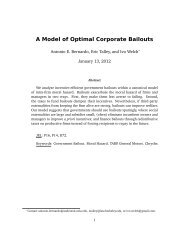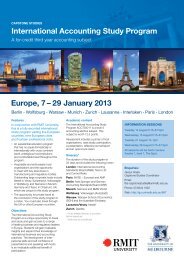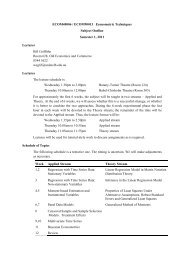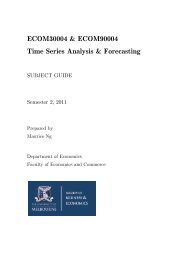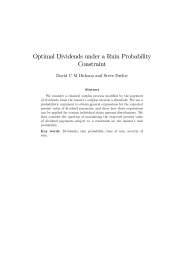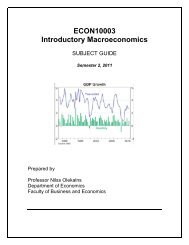Bayesian Inference in the Seemingly Unrelated Regressions Model
Bayesian Inference in the Seemingly Unrelated Regressions Model
Bayesian Inference in the Seemingly Unrelated Regressions Model
Create successful ePaper yourself
Turn your PDF publications into a flip-book with our unique Google optimized e-Paper software.
30<br />
−1<br />
f( y* | β, y) ∝ ⎡1 ( y* X* )′<br />
A ( y* X ⎤<br />
⎣<br />
+ − β − * β<br />
⎦<br />
− ( T + 1) 2<br />
⎡<br />
−1<br />
⎛ A ⎞<br />
⎤<br />
∝ ⎢v* + ( y* − X* β) ′ ⎜ ⎟ ( y* − X*<br />
β)<br />
⎥<br />
⎢<br />
v<br />
⎣<br />
⎝ * ⎠<br />
⎥<br />
⎦<br />
− ( M+<br />
v ) 2<br />
*<br />
(54)<br />
where v* = T − M + 1. Equation (54) is a multivariate t-distribution with mean<br />
E( y | β , y)<br />
= X β (55)<br />
* *<br />
covariance matrix<br />
V( y*<br />
| β , y)<br />
=<br />
v<br />
*<br />
A<br />
− 2<br />
(56)<br />
and degrees of freedom v *<br />
. Given draws β ( $ ) , $ = 1,2, …, N from an MCMC<br />
algorithm, one can average <strong>the</strong> quantities <strong>in</strong> equations (54) to (56) over <strong>the</strong>se draws to<br />
estimate <strong>the</strong> required marg<strong>in</strong>al predictive pdf’s and <strong>the</strong>ir moments. Marg<strong>in</strong>al<br />
univariate t distributions from (54) are averaged and <strong>the</strong> formulas are analogous to<br />
those <strong>in</strong> equations (22), (26) and (27) except, of course, that our random variable of<br />
<strong>in</strong>terest is now an element of y * , say y *i , not β ik .<br />
Percy (1992) describes an alternative Gibbs sampl<strong>in</strong>g approach where y * , β<br />
and Σ are recursively generated from <strong>the</strong>ir respective conditional pdf’s. With our<br />
approach, it is not necessary to generate draws on y * . Also, because we have derived<br />
<strong>the</strong> predictive pdf conditional on β , <strong>the</strong> <strong>in</strong>troduction of <strong>in</strong>equality restrictions on β<br />
does not change <strong>the</strong> analysis. The range of values of β over which averag<strong>in</strong>g takes<br />
place is restricted, but that is accommodated by <strong>the</strong> way <strong>in</strong> which β is drawn, and <strong>the</strong><br />
result <strong>in</strong> (54) still holds.<br />
An <strong>in</strong>terest<strong>in</strong>g extension, and one that is of concern to Griffiths et al. (2001), is<br />
captur<strong>in</strong>g <strong>the</strong> extra uncerta<strong>in</strong>ty created by not know<strong>in</strong>g <strong>the</strong> value of one or more



